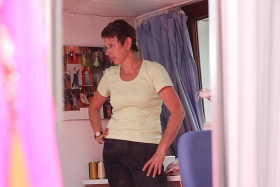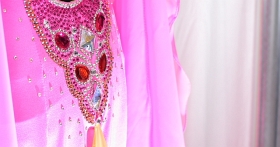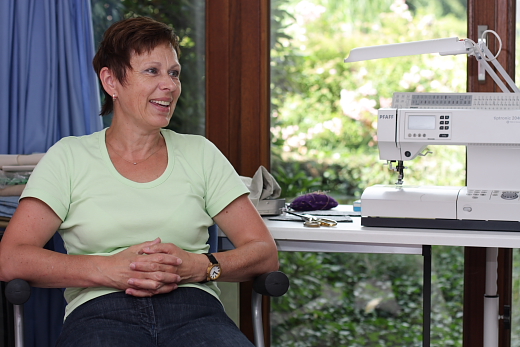1
A Second Skin: Claudia Dunker On Ladies' Gowns, Lycra, And Sequins.
Text: Kerstin Lange Photography: Helmut Römhild
... the passion for the city of Milan — and for fashion!
But while for Garavani, head of the Valentino fashion label, Milan was the beginning of an exceptional career,
for Claudia the city in northern Italy remained far away, eventually became a holiday destination.
And her tailor's workshop is situated at the outskirts of Hamburg, not in Rome or glamorous Paris.
But as in Valentino's studios you will find everything a designer needs to match raw material and imagination, and to create this very special thing which is more than just a dress, something a lady doesn't just wear but becomes her second skin.
Claudia Dunker in her tailor's workshop.
Claudia Dunker dresses the ladies —
to compete successfully on the dancing floor, in other words: for hard work, for physical excercise.
Here is the person you would want to talk to if you are desperate for advice on what to wear in front of the judges.
Claudia Dunker knows exactly what dancers worry about because she has been dancing since her teenage years,
took part in contests for 32 years, started to compete seriously 20 years ago.
And how many dresses
did she produce in her workshop?
Claudia is not quite certain. But definitely more than twenty.
And the first piece by Claudia Dunker?
A bright red denim suit — when she was 16 years old.
Needless to say that Claudia still turns to Milan's Master of Fashion for inspiration:
“I love to browse in a ‘Valentino’ magazine. This is where I find the best ideas.”
Why tailormade?
It is all about personality, the dancer's term is ‘expression’,
and the lady's dress is definitely part of it:
“Before making a dress for a friend I try to catch what's special about her, what matches her style,
try to find the individual color pattern.”
The result is a dress which fits like a ‘second skin’, something unique which lets
the dancers stand out on the floor, the visual equivalent of personality.
“The dress takes shape in my imagination when I see the colours of the fabric.
Suddenly I know what I want to create. My designs are based on the theory of colors in arts. ”
Claudia's fashion definitely profits from her lessons in watercolours and acrylic painting.
Through combining colours and fabrics
Claudia succeeds in creating her own, very characteristic style.Another typical detail is the result of her extraordinary patience und skill: The thousands of sequins arranged into ornaments.
“Making a dress is very similar to painting. I start by visualising what I would like to make but during the process of actually making it the dress develops a life of its own. The result is always different from what I had in mind but in the end everything falls into place. Such a dress is not just a manufactured product but a piece of art created with patience and affection. ”
Needless to say that Claudia is also the expert when it comes to mending wear and tear and tending to dancer's dresses.
The pieces of fabric, cut according to the individual patterns, are joined on the sewing machine.
The dresses usually combine Lycra™ and ‘Georgette’.
‘Georgette’ does not stretch, Lycra™ does and can be extended to extreme length.
Lycra™ and ‘Georgette’ are joined with ‘stretch stitches’ so the desired overall elasticity is preserved. A corselet gives shape to the outer shell.
Flexibility matters in dancing:
The lady's dress has to be lightweight. It has to stretch and go along with the movements. It has to ventilate the body and keep the body dry.
In comparison the gentleman's tailcoat consisting of wool, kashmir and mohair seems to be a knight's armour.
Sequines are attached with glue.
Claudia buys fabrics wholesale. Also the corselets come prefabricated.

The dancers' clothes are still related to the origins of today's ‘Ten Dances’.
Ballroom dancers compete in full evening dress — the gentleman in white tie, the lady in a ball gown
because their dances were — and still are — part of the formal social events, to be performed under the large chandliers of busy ballrooms.
The Latin dancer's outfit underlines the informal and spontaneous character of the original dances, remind us of the hot and tropical countries, which gave these dances to us.
Looking at the ball gowns
we tend to forget that the dancers' dresses are sportswear, exposed to real punishment: Stretch, abrasion (the result of body contact), moisture, tearing and ripping(Latin's acrobatics, falls) — and from the contest into the washing ...
One material takes all this and more: Lycra™.
Lance Armstrong on his racing bike, Reinhold Messner climbing Everest: There is no sport, no field of athletics without Lycra™.
It is an artificial fibre which can be stretched by 500% of it's original length, resisting abrasion, repelling liquids, retaining the colour.
Lycra™ usually comes combined with other materials, making up 20% of the fabrics and accounting for the efficient transportation of body moisture away from the skin while fitting tight, always staying in shape.
For the finishing touch
a ‘traditional’ fabric comes into play: Georgette. Lightweight, transparent (‘Crépe Georgette’) nevertheless providing a strong, almost ‘granular’ quality, made from natural fibres, nowadays also artificially. It gives elegance to the gown.
They end up on the floor
sparkling and glittering, to be swept away when the contest is over: cristals and paillettes, the bits and pieces which form one of the characteristics of the lady's gown, the ornaments.
Paillettes
Extremely small drilled discs or tubes,
either sewn to the gown or, more often, glued to the fabric.
Paillettes, attached to the gown with needle and thread, add to the price: Manual labour is expensive.

Svarovsky-Cristals
They come in all sizes from quite large to tiny and can either be sewn or glued to the gown. About 5000 to 7000 cristals are needed to decorate the top part of a lady's dress. It takes Claudia seven to ten days to glue the cristals to the fabric. the ornament is extremely robust and survives hand washing without a problem.
![]()
©: Ballroom Website, 2008
Aktualisiert: 27.10.2008


